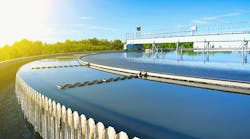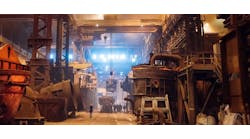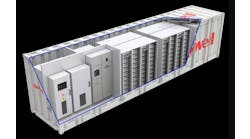This article is part of a series on industrial sustainability. Read more here.
Simulations are only as good as the process measurements they use. However, just as they enable operations and efficiency, they can also be used to improve sustainability.
For instance, Goldwind Environmental Protection Co. and its subsidiary, Shuyang Lingzhi Water Affair Co., treat 79,000 tons of industrial wastewater per day at their Phase I and II plants in northeast Shuyang Lingzhi province, China. They recently implemented controls and data-driven modeling for optimization (DDMO) from Yokogawa to help manage large daily fluctuations in the plants' influent wastewater and comply with new environmental regulations.
Specifically, each reaction tank in this wastewater treatment process needs enough aeration to ensure effluent quality and compliance with regulatory limits. This requires maintaining air-blowing rates in the tanks with a sufficient safety margin, though the process can also waste electricity. The tanks account for at least 40% the power used by the plants. To reduce energy consumption and keep effluent quality below statutory limits, Goldwind and Shuyang Lingzhi worked with another Goldwind subsidiary, Etechwin Electric Co., to adopt Yokogawa's aeration optimization solution by implementing its Centum VP DCS, DDMP and SCADA system to automate the their formerly manual air-blowing equipment, as well as their sludge pumps, digestion liquid circulation pumps and sludge withdrawal pumps.
To estimate effluent quality and maintain it in conjunction with the DCS, DDMO was configured to estimate the chemical oxygen demand (COD) and ammonium (NH4) concentrations in the treated effluent. Modeled on items like inflow to the plants, water quality and power consumption, DDMO estimates effluent quality based on historical data like flows, water quality and retention time, and uses them to determine optimum air-blowing rates that can save energy. By controlling pumps and other devices, the DCS stabilizes the treatment process, suppresses water quality fluctuations, and improves DDMO's accuracy.
In addition, DDMO's effluent quality calculation interval was set at 15 minutes, so it transfers optimum blowing rates to the DCS every 15 minutes as well. It's also configured to reflect correlations between online data and its model formula to further improve its estimates. Plus, an NH4 sensor was added to measure its concentration at the outflow of each tank, which is useful because how much nitrogen is removed by nitrification and denitrification influences the effluent's nitrogen concentration.
Beyond reducing blower electricity consumption by 25.1% at one plant and 24.7% at the other over three months, Goldwind and Shuyang Lingzhi reported these gains continued during the following year. “We're grateful for Yokogawa’s control and optimization technologies that delivered expected benefits," says Zhang Guangbo, executive and managing director at Shuyang Lingzhi. "Because our sewage treatment facilities consume so much energy, Goldwind needs to work harder to save energy for sustainable operations in the future. We look forward to continuing to work with Yokogawa to achieve energy efficiency with the latest technologies.”
Making sustainability
"Users must be able to continue operations and grow their businesses, but they also need to fulfill the expectations of their customers, staff, shareholders and communities towards a more sustainable world " says Sergio Fernandes, chemical market director for North America at Yokogawa. "Fortunately, sustainability has long been part of Yokogawa's culture, and it's been making yearly sustainability and social responsibility reports since 1999. It began by reducing use of non-environmentally friendly materials in its own operations, and as time went by, it began talking to customers and helping them with sustainability, too. In 2017, Yokogawa also began discussing timeframe goals. The company has pledged to achieve net-zero emissions in its operations by 2050, and it's encouraging its customers and the process industries to do the same. Starting in 2030, it's also going to show its progress each year. We want to remove 1 billion tons of CO2 from the atmosphere during 2018-30."
To achieve these green goals, Fernandes agrees that Yokogawa and its clients can use software and hardware that have been available for several decades, but often weren't as visible before sustainability became more of a priority. These technologies include laser spectrometers in combustion areas, or CO, CO2 and methane detectors. "These instruments can now provide measurements fast enough to guide operators to use less oxygen and fuel in their processes, and produce less greenhouse gases," explains Fernandes. "Of course, many plants operate multiple units and run complex operations between those units, so it can be hard to gauge their energy consumption and emissions.
"These processes may also have limited degrees of freedom for adjustments, but our KBC consulting division can help by making mathematical models, simulations and digital twins, finding minimum consumption points, and developing algorithms to optimize their production and make it more sustainable. For example, the KNTC refinery in Kuwait recently wanted to reduce its consumption and emissions, so it applied these mathematical models to all its equipment and developed digital twins, and we recommended better operations points. This resulted in KNTC saving $4 million per year and producing 27,000 fewer tons of CO2."
For other operators and engineers who want to make similar gains, Fernandes emphasizes they must map where their applications, equipment and facilities are at to address their individual characteristics and requirements. "Each site is different. They have different connections, different procedures for delivering raw materials, and different processes and products. So, we need detailed engineering to develop precise calculations and useful models," explains Fernandes. "Many users have been running their plants for 20-30 years, and know their quirks better than anyone, so KBC's chemical engineers consult with them. Together, they confirm operating constraints and degrees of freedom, identify opportunities for efficiencies and sustainability, and develop models and simulations to achieve them.
"Sustainability doesn't have to be a stressful topic. We're really just talking about saving energy. All people need is an open mind and a little willingness to engage."







